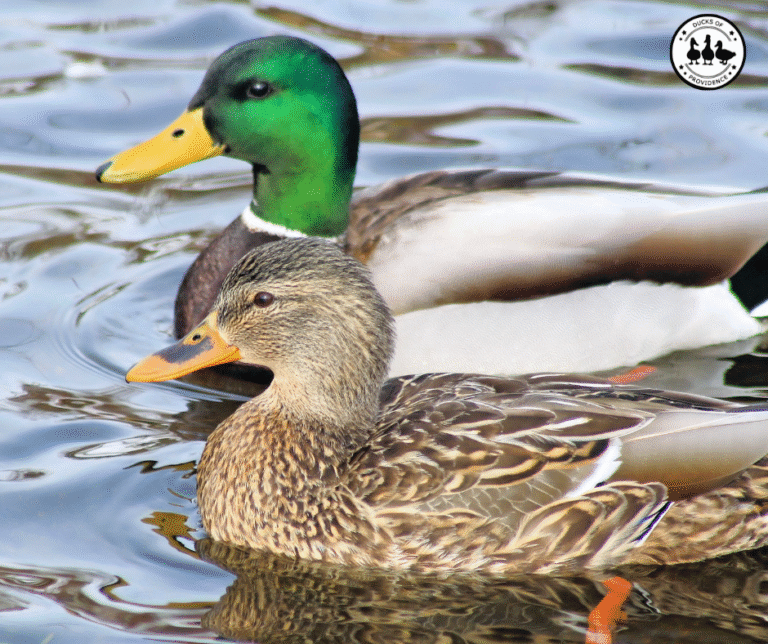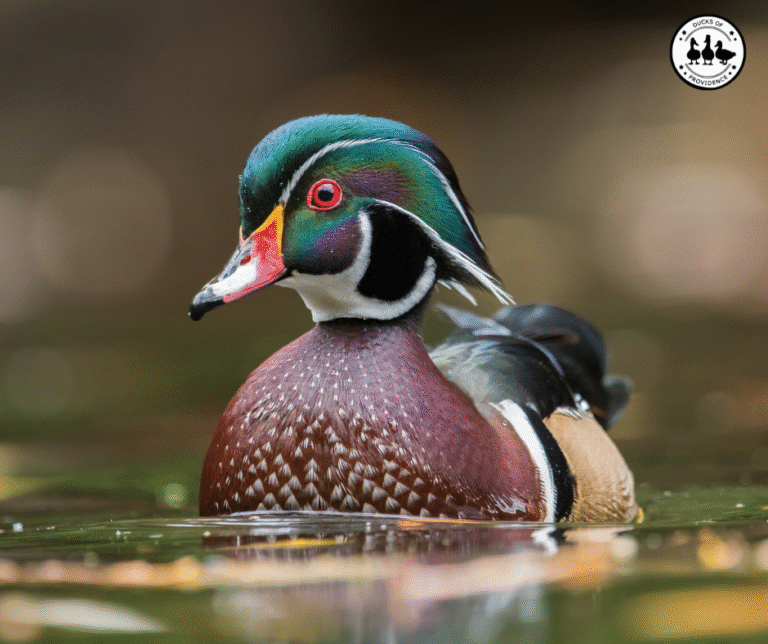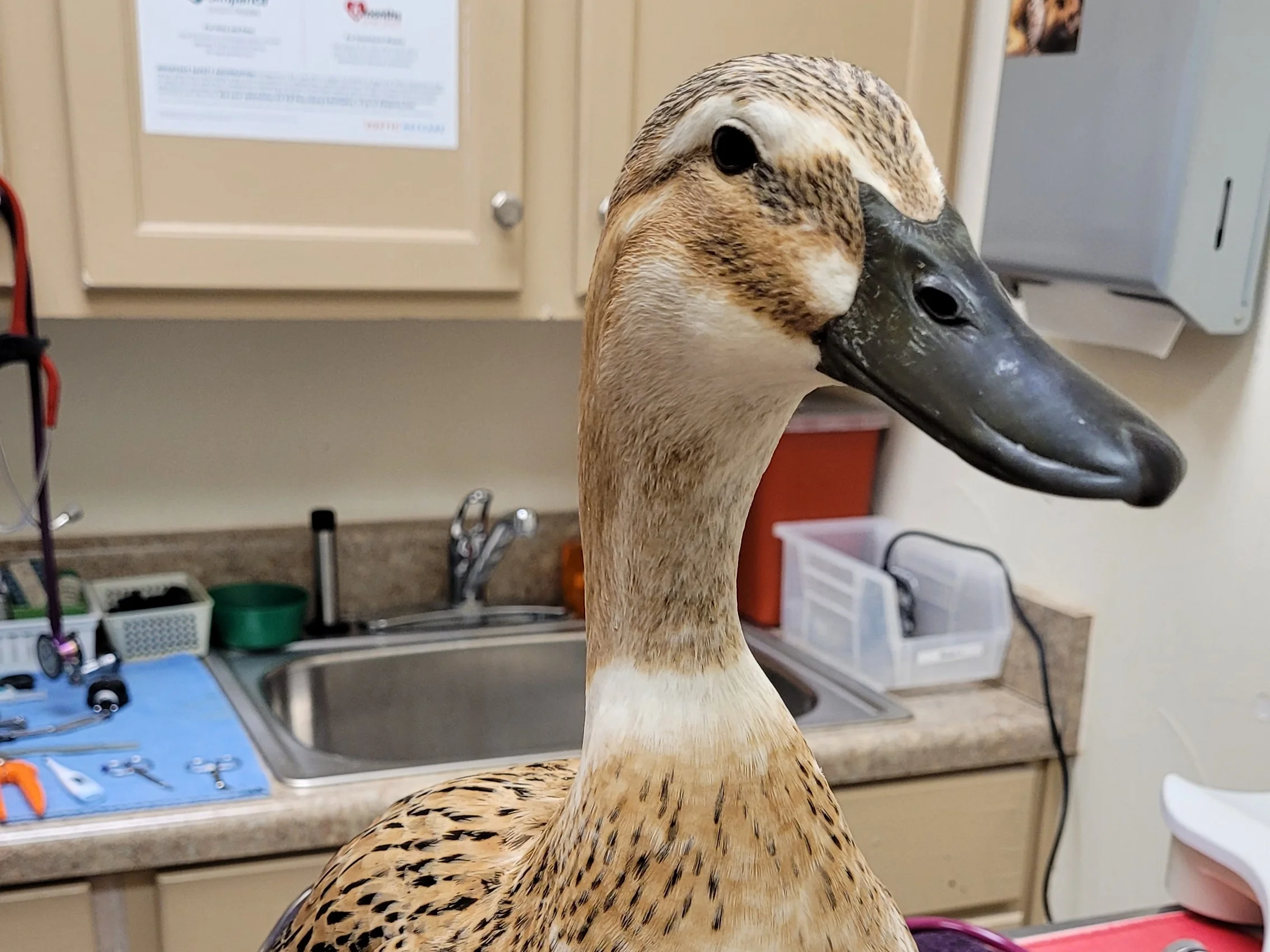
16 Common Duck Health Conditions You Should Know About
Last updated on April 7th, 2025 at 08:03 pm
In this post, we’ll examine common health issues, injuries, and illnesses that ducks may encounter, providing insights into proactive measures to ensure the well-being of our feathered friends.
While ducks are generally hardy and easy to care for, they, like all animals, can face various health challenges. Today, we’re delving into a crucial topic for every duck parent – the health of our quacky companions. As the proud owner of seven delightful ducks, I’ve navigated through my fair share of health concerns, gaining valuable lessons along the way.
Ducks of Providence is free, thanks to reader support! Ads and affiliate links help us cover costs—if you shop through our links, we may earn a small commission at no extra cost to you. Thanks for helping keep our content free and our ducks happy! 🦆 Learn more
Some of the most common duck health conditions include:
The order is alphabetical and not by severity. You will find links to articles that go more in-depth on these health conditions at the end of every section.
1. Angel Wing in Ducks
This condition typically occurs when the last joint of the wing twists outward, preventing proper flight and causing the wing to jut out unnaturally. This is only a cosmetic issue and does not impact the quality of life of your pet ducks, as they are (most likely) unable to fly anyway.
Angel wing often stems from a high-calorie diet, particularly an excessive intake of carbohydrates and protein, leading to rapid growth and improper development of the wing feathers and bones in young, growing ducks.
Preventative measures involve providing a balanced diet rich in vitamins and minerals, ensuring appropriate protein levels, and avoiding overfeeding.
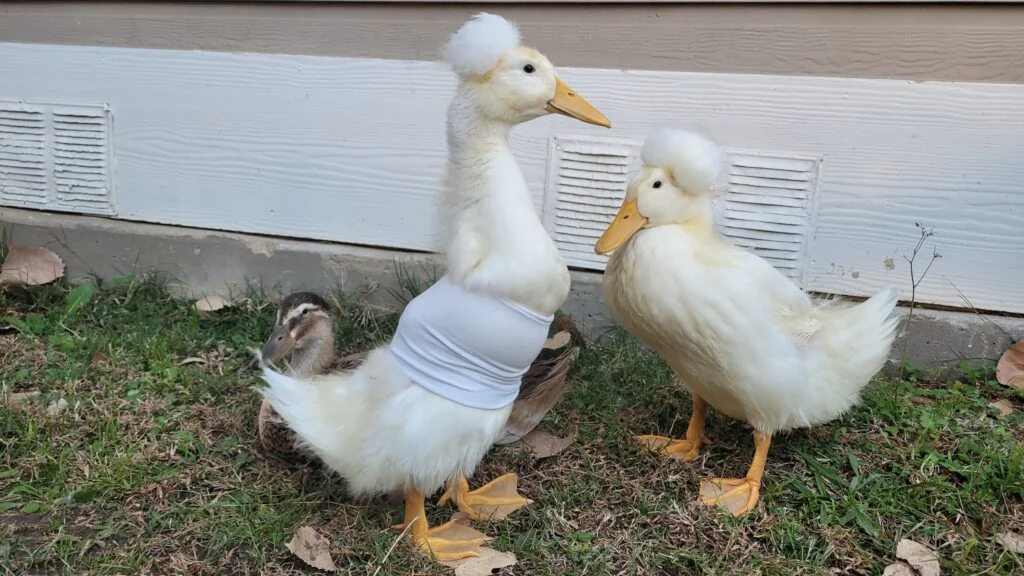
Angel wing can be corrected when detected early. Supportive care includes wrapping the affected wing with a soft bandage or brace to aid in realigning the wing. Awareness and proactive steps play a significant role in mitigating the occurrence of angel wing in our beloved ducks.
➡️ Read More: Angel Wing in Ducks (Causes, Treatments, and More)
2. Arthritis in Ducks
Arthritis is a condition that causes inflammation and pain in the joints. Ducks, especially as they grow older, may develop arthritis, causing inflammation and stiffness in their joints. Factors like excessive weight, inadequate exercise, or previous injuries can exacerbate this condition.
Jumbo Pekins are especially prone to this condition because they were bred as meat birds and are relatively heavy for their size.
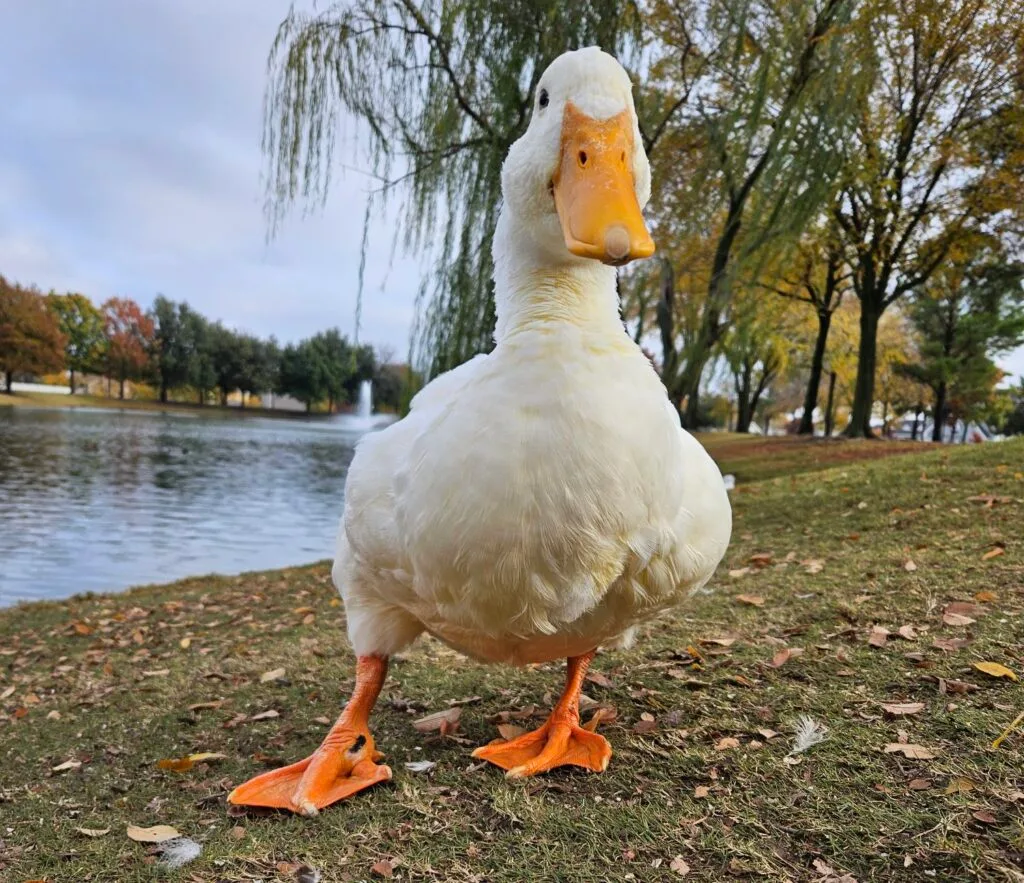
To prevent arthritis, providing a suitable habitat with soft bedding and ensuring ample space for movement can aid in reducing joint stress. Additionally, maintaining a balanced diet rich in nutrients that support joint health, such as omega-3 fatty acids, can alleviate the risk of arthritis.
If symptoms arise, consulting a veterinarian for proper diagnosis and potential treatments like pain management or physical therapy is essential to ensure the comfort and well-being of our ducks.
In very severe cases, you can get your duck a wheelchair to improve their mobility.
➡️ Read More: Arthritis in Ducks: Understanding, Managing, and Supporting Your Feathered Friends
3. Aspergillosis in Ducks
Aspergillosis, a fungal infection caused by Aspergillus mold, poses a serious threat to the respiratory system of ducks. This condition often arises when ducks inhale spores in moldy bedding, feed, or damp environments.
Aspergillosis manifests through respiratory distress, wheezing, and lethargy, among other symptoms.
Prevention involves maintaining a clean and dry living space, regularly inspecting bedding for mold, and ensuring proper ventilation to minimize mold growth. If suspected, immediate veterinary attention is crucial for diagnosis and appropriate treatment, including antifungal medications or supportive care to alleviate respiratory distress.
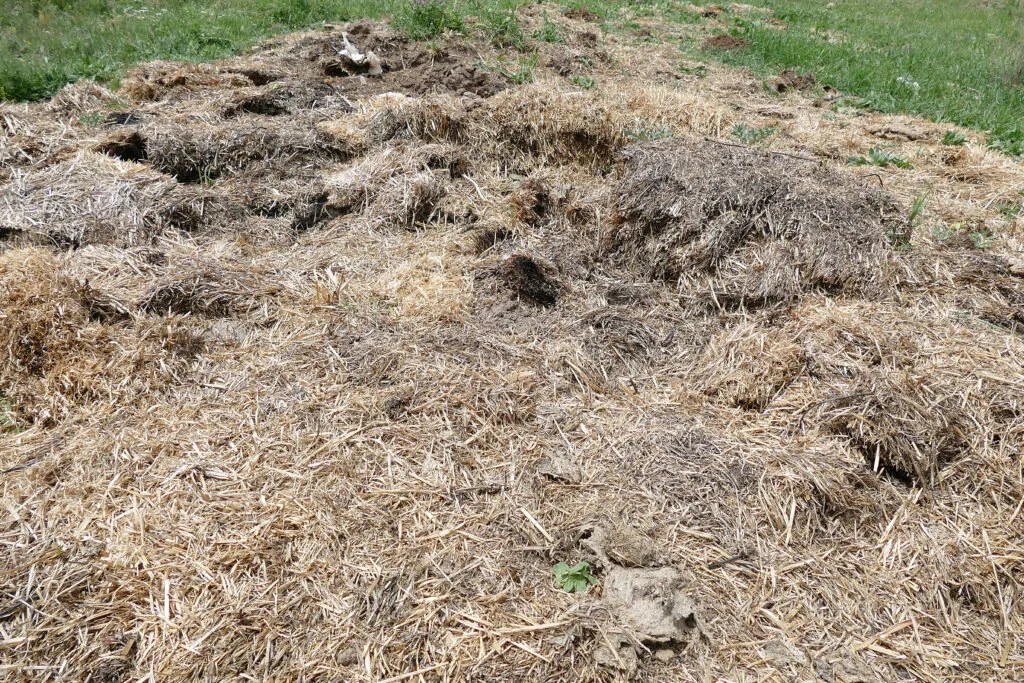
Proactive measures and a vigilant eye can significantly reduce the risk of Aspergillosis, safeguarding the respiratory health of our beloved ducks.
➡️ Read more: Aspergillosis in Ducks: Causes, Symptoms, Prevention, and Treatment
4. Avian Influenza
Avian influenza, commonly known as bird flu, poses a significant threat to duck populations worldwide. This highly contagious viral infection affects ducks’ respiratory, digestive, and sometimes neurological systems.
Symptoms range from mild, such as reduced egg production, to severe, including respiratory distress and sudden death.

Avian influenza can be spread through contact with infected birds or their feces. Prevention involves stringent biosecurity measures, including limiting contact between wild birds and domestic ducks, ensuring hygienic conditions in and around their habitat, and monitoring for any unusual signs or sudden deaths within the flock.
Prompt reporting of suspected cases to veterinary authorities is crucial to prevent the spread of the virus. Vaccination in high-risk areas and following regional guidelines are vital steps in safeguarding our ducks against avian influenza.
➡️ Read more: Understanding Avian Influenza (Bird Flu)
5. Botulism in Ducks
Botulism, a severe and potentially fatal illness, can afflict ducks due to ingesting toxins produced by the bacterium Clostridium botulinum.
This condition often arises from consuming contaminated water or feed, particularly in stagnant or decaying environments.
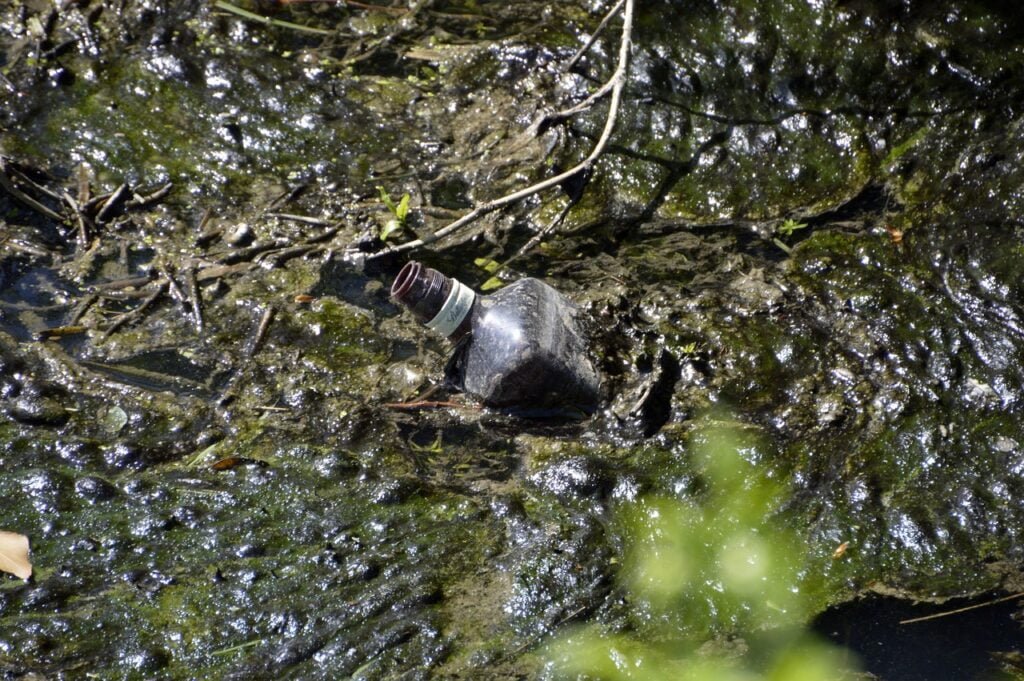
Symptoms may include weakness, paralysis, difficulty breathing, and, in severe cases, death.
Prevention involves vigilant monitoring of water sources, ensuring they are clean and free from decomposing organic matter. Proper waste management and promptly removing carcasses or decaying material near the ducks’ habitat are crucial preventive measures.
If suspected, immediate veterinary attention is vital for supportive care and treatment to minimize the effects of the toxin.
➡️ Read more: Botulism in Ducks: Causes, Symptoms, Treatment, and Prevention
6. Bumblefoot in Ducks
Bumblefoot, a common condition among ducks, is a bacterial infection of the feet characterized by swelling, redness, and the formation of a pus-filled abscess.
This ailment typically stems from injuries or irritation caused by rough or unsuitable surfaces in the ducks’ environment.
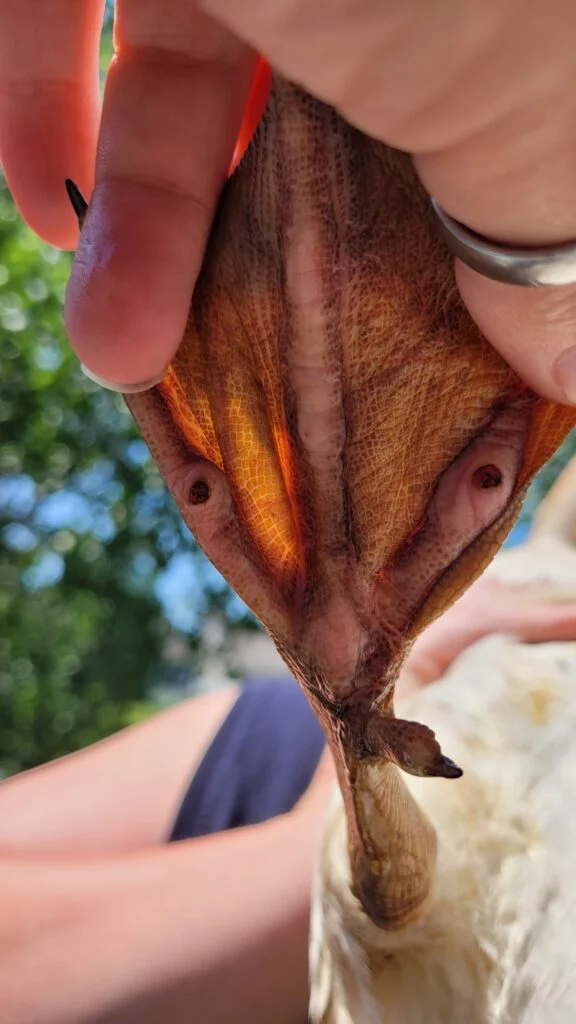
Prevention involves maintaining clean and dry living spaces, providing suitable flooring such as grassy areas or soft bedding, and regularly inspecting the ducks’ feet for any signs of injury or swelling.
Immediate attention to minor injuries, along with proper wound care and disinfection, can prevent the development of bumblefoot. If detected, prompt veterinary care, including antibiotics and appropriate wound management, is necessary for treatment.
➡️ Read More: Bumblefoot in Ducks: Symptoms, Causes, and Treatments
7. Duck virus enteritis (duck plague)
Duck Virus Enteritis (DVE), commonly known as duck plague, is a highly contagious and often fatal viral disease affecting ducks. The Anatid herpesvirus-1 causes this disease.
Duck virus enteritis is most common in young ducks and is spread through contact with infected birds or their feces.
Ducks infected with DVE may exhibit symptoms like loss of appetite, lethargy, diarrhea, and neurological signs.
Prevention primarily involves strict biosecurity measures, including controlling access to the flock, limiting contact with wild waterfowl, and disinfecting regular equipment and living areas. Vaccination against DVE is available and recommended in high-risk areas or for valuable breeding stock.
Immediate isolation of infected birds and prompt veterinary consultation are crucial if suspected.
➡️ Read More: Duck Virus Enteritis: How to Protect Your Flock from This Deadly Duck Disease
8. Egg binding and soft-shelled eggs in Ducks
Egg binding and soft-shelled eggs in ducks are two concerns that often affect their reproductive health. Egg binding occurs when a duck cannot lay an egg for various reasons, such as a malformed egg, calcium deficiency, or an underlying health issue.
This condition can be identified by a duck’s distress, reduced activity, and visible straining.
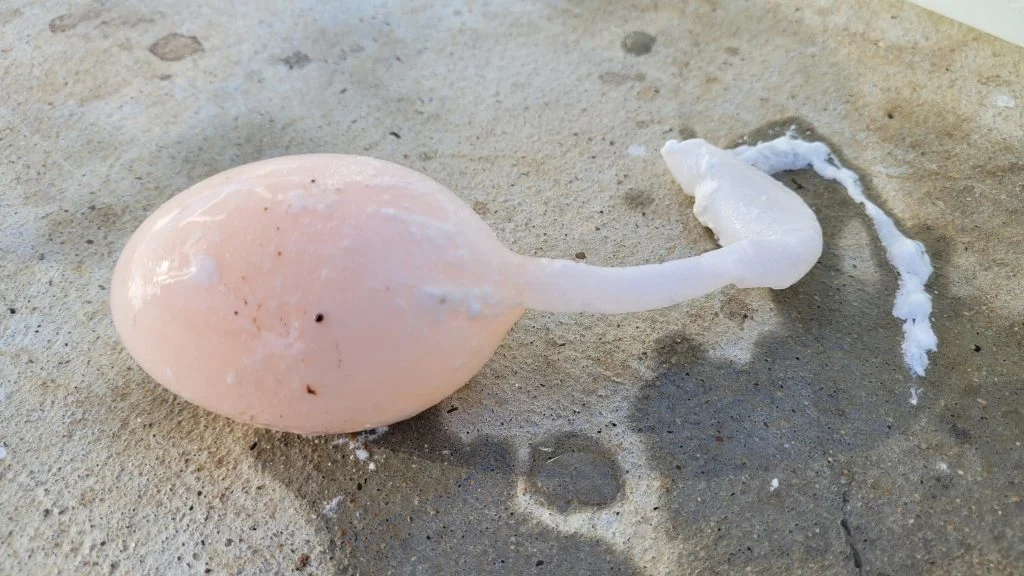
Soft-shelled eggs, on the other hand, result from inadequate calcium levels, causing the eggshell to be thin or malformed.
To prevent these issues, provide a balanced diet rich in calcium, supplement their diet with crushed oyster shells or specialized poultry calcium supplements, and ensure a stress-free environment.
If you suspect egg binding or consistently notice soft-shelled eggs, seek immediate veterinary attention to prevent complications and support your duck’s reproductive health.
Read More:
➡️ Breaking Down Egg Binding in Ducks: What Every Duck Keeper Should Know
➡️ Soft-Shelled Eggs in Ducks – Everything You Need to Know
9. Eye Infections in Ducks
Ducks with eye infections often exhibit signs like swelling, redness, discharge, or a cloudy appearance in one or both eyes. You might also notice them rubbing their eyes with their wings or seeming generally uncomfortable.
These infections can arise from various sources, including bacteria, fungi, viruses, or environmental irritants like dust and debris. To prevent these issues, it’s important to keep your ducks’ living environment clean and dry, and to provide fresh, uncontaminated water. Regularly check your ducks for any signs of eye problems, and if you notice symptoms, separate the affected ducks to prevent spreading the infection.
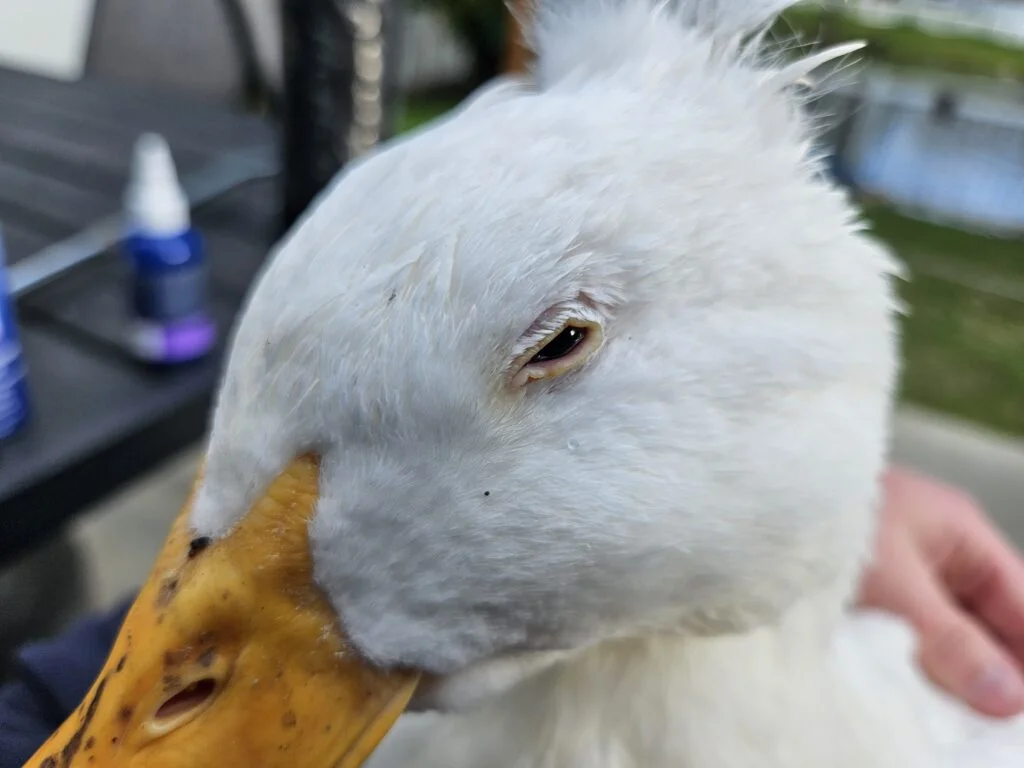
If the symptoms persist, it’s essential to seek veterinary care. They can provide the appropriate treatment, such as antibiotic eye drops, to address the infection effectively. With prompt attention and proper care, they can ensure your ducks’ eyes remain clear and healthy, contributing to their overall well-being.
➡️ Read More: Understanding and Managing Eye Infections in Ducks
10. Impacted Crop in Ducks
An impacted crop in ducks is a concerning condition where the food, usually grains, long strands of grass, or other feed, becomes lodged or impacted in the digestive tract. This often happens when ducks consume indigestible material or eat too quickly without adequate access to grit.
Signs of an impacted crop include a visibly swollen area around the crop, decreased appetite, lethargy, and difficulty swallowing.
To prevent this, ensure your ducks have access to clean water and proper grit for digestion, and feed in a manner that discourages rapid consumption. If you suspect an impacted crop, consult a veterinarian experienced in avian care immediately for proper diagnosis and treatment.
In mild cases, you can put the duck on water only for 24 to 48 hours to allow the crop to empty itself before gradually re-introducing them to food.
Regular monitoring and thoughtful feeding practices can help prevent this uncomfortable condition in your beloved feathered friends.
➡️ Read More: Impacted Crop in Ducks: Causes, Symptoms, Treatment, and Prevention
11. Leg Injuries in Ducks
Leg injuries can significantly impact a duck’s mobility and well-being, often arising from accidents, falls, or environmental hazards.
These injuries may include fractures, sprains, or strains, which can lead to limping, swelling, or a reluctance to move.
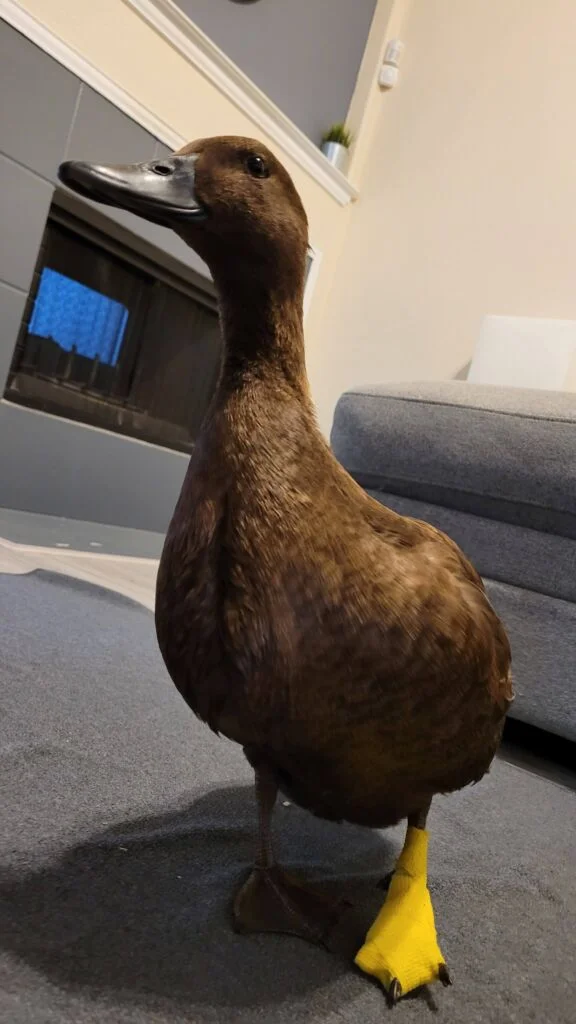
Preventing leg injuries involves maintaining a safe, obstacle-free environment for ducks, free from sharp edges or objects that could harm them.
If an injury occurs, providing immediate care by gently examining the affected leg for signs of damage, such as swelling or deformity, is crucial. Immobilizing the injured leg, providing a safe and comfortable space for rest, and consulting a veterinarian for proper diagnosis and treatment are essential steps.
Rehabilitation measures, such as physical therapy or supportive care, may aid in recovery and restore the duck’s mobility.
➡️ Read More: Limping Ducks? Understanding Leg Injuries in Ducks and How to Help
Watch the video below to learn how to bandage a duck foot after injury:
12. Parasites in Ducks
Parasites in ducks can pose health risks and discomfort to our feathered friends. These organisms, ranging from external mites to internal worms, can affect ducks of all ages.
External parasites like mites and lice typically cause itching, irritation, and feather damage, leading to stress and potential infections. Regular health checks and providing clean bedding are crucial in preventing these pests.

Internal parasites like worms can affect the digestive system, causing symptoms like diarrhea and weight loss. Proper hygiene, regular deworming, and vet consultations are vital in managing and preventing internal parasite infestations.
Ensuring a clean living environment and a balanced diet are key factors in maintaining the well-being of our beloved duck companions.
➡️ Learn more about internal duck parasites in this post: 8 Internal Duck Parasites You Should Be Aware Of.
➡️ Learn more about external duck parasites in this post: Common External Duck Parasites: Signs, Treatment, and Prevention Tips
13. Prolapse in Ducks
Prolapse in male and female ducks is a distressing condition where internal organs, typically the reproductive or digestive tract, protrude from the vent.
In females, reproductive prolapse occurs when the oviduct or cloaca protrudes, often due to excessive egg-laying or egg-related complications.
In males, prolapse can involve the cloaca or phallus. This condition is often triggered by excessive mating, injury, or underlying health issues.
Symptoms include visible tissue protrusion, discomfort, and inactivity. Immediate veterinary attention is crucial to address prolapse, which can lead to serious infections or further complications.
Treatment may involve gentle cleaning and repositioning of the prolapsed organ and supportive care to alleviate discomfort and prevent infection.
Preventive measures include maintaining a balanced diet, ensuring a stress-free environment, and monitoring mating behaviors to reduce the risk of prolapse in your duck flock.
➡️ Read More: Prolapsed Phallus (Penis) in Pet Ducks or Prolapsed Vent in Ducks: Causes, Treatment, and Prevention
14. Respiratory Conditions in Ducks
Like humans, ducks can experience respiratory issues. These can manifest due to various factors, including exposure to damp environments, poor ventilation, or infectious agents.
These ailments often include sneezing, coughing, nasal discharge, or labored breathing.
Preventing respiratory ailments involves ensuring a well-ventilated and dry living space for ducks, regularly cleaning their habitat, and avoiding exposure to drafts or extreme temperature changes. Implementing biosecurity measures, such as limiting contact with potentially infected birds, also reduces the risk of respiratory infections.
Immediate veterinary consultation upon noticing respiratory symptoms is crucial for proper diagnosis and treatment, including antibiotics, supportive care, or adjusting the living environment.
➡️ Read More: Ducks Coughing: Causes, Symptoms, and Solutions
➡️ Read More: Recognizing and Addressing Respiratory Conditions in Ducks

15. Wry Neck in Ducks
Wry neck, a distressing condition observed in ducks, manifests as an abnormal twisting or tilting of the neck, impacting their mobility and coordination. This condition, often called torticollis or crook neck, can present as a duckling holding its head at an awkward angle or struggling to maintain balance. It is sometimes described as a sideways “S” bend neck.
The primary culprit behind wry neck is often attributed to nutritional deficiencies, particularly insufficient levels of essential vitamins like Vitamin E or selenium. Swift action is crucial: providing immediate dietary adjustments, such as offering vitamin supplements or a balanced diet rich in vital nutrients, and seeking prompt veterinary consultation can be pivotal in managing and potentially reversing wry neck in ducks.
Wry neck and limberneck (neck paralysis) are occasionally mistaken for each other. Limberneck, primarily a symptom associated with botulism, avian flu, or poison ingestion, presents as neck paralysis in ducks.
➡️ Read More: Wry neck in ducks
16. Wet Feather in Ducks
This is a condition in which a duck’s feathers become waterlogged and lose their ability to repel water and insulate the bird.
This condition arises due to various factors such as insufficient preening, dysfunction of the oil glands, or prolonged exposure to excessive moisture.
Ducks affected by wet feather lose their feathers’ ability to repel water, compromising their insulation and exposing them to environmental challenges.
Prevention involves providing a dry and clean living space, ensuring proper nutrition for healthy feather growth, and minimizing exposure to prolonged dampness.
If ducks develop wet feather, supportive care through gentle drying (even with a hair dryer), fostering a dry environment, and encouraging natural preening can aid recovery.
Sometimes, you need to wait until the duck molts. Molting helps with wet feather by allowing the growth of new, healthy feathers. As the old, waterlogged feathers are shed, the new feathers that grow in their place tend to be healthier and better equipped to repel water.
➡️ Read More: Why Wet Feather in Ducks Happens and How to Fix It

Preventing Duck Health Conditions
There are some things you can do to prevent duck health problems:
- Clean Living Space: Maintain a clean and dry environment for ducks, regularly cleaning their living area to prevent the buildup of waste and bacteria.
- Nutritious Diet: Offer a balanced and nutritious diet suitable for ducks, including appropriate protein levels and essential vitamins and minerals.
- Fresh Water: Ensure access to clean and fresh water, regularly changing and monitoring water sources to prevent contamination.
- Proper Ventilation: Provide adequate ventilation in their housing to avoid respiratory issues caused by poor air quality.
- Biosecurity Measures: Implement biosecurity practices to limit disease exposure, including quarantining new ducks, restricting contact with wild birds, and disinfecting equipment.
- Regular Health Checks: Conduct routine health checks, observe ducks for signs of illness or abnormal behavior, and seek veterinary attention promptly if needed.
- Predator Protection: Secure their living area to protect ducks from predators, reducing stress and potential injuries.
- Parasite Control: Implement measures to control parasites such as mites, lice, or worms through regular checks and appropriate treatments.
- Monitoring Behavior: Pay attention to their behavior, ensuring they are active and alert and displaying regular feeding and socializing patterns.
By following these tips and maintaining a proactive approach to duck care, you can significantly reduce the risk of health problems and ensure the overall well-being of your duck companions.
Another excellent source to explore duck health issues is DUCKDVM.com. This page is maintained by avian vets and has an extensive library of duck health conditions, a symptom checker, and multiple case studies. We also check their website regularly to dive deeper into the health issues our ducks face.

This is the BEST book about ducks I have ever had. I can highly recommend it to every duck owner, new or experienced. It is very comprehensive with pictures and illustrations. It covers all topics related to duck care and keeping ducks. It even has multiple case studies.
Treating Duck Health Conditions
The treatment for duck health problems will vary depending on the specific problem. However, some general treatment options include:
- Isolation and Rest: For infectious diseases or injuries, isolating the affected duck and providing a quiet, stress-free environment can aid recovery.
- Hydration and Nutrition: Ensuring proper hydration and nutrition is crucial. Provide clean water and a balanced diet suited to their age and health needs.
- Medication: Antibiotics or antifungal medications prescribed by a veterinarian can treat bacterial or fungal infections. Follow dosage instructions diligently.
- Wound Care: Cleaning and treating wounds with antiseptic solutions or ointments can prevent infections and promote healing.
- Supportive Care: Providing warmth, gentle handling, and comfort can aid in the recovery of ducks suffering from various health issues.
- Surgical Intervention: Surgery might be necessary in severe cases, especially for conditions like prolapse or injuries requiring repair.
- Supplements: Administering specific supplements such as vitamins, minerals, or probiotics as recommended by a vet can aid in recovery and support overall health.
Remember, while these are general treatment options, seeking professional veterinary advice tailored to the specific health concern is crucial for effective treatment and the well-being of your ducks.

It is important to note that some duck health problems are not curable. In these cases, the goal of treatment is to make the duck as comfortable as possible.
Share Your Experiences
I would love to hear about your experiences with duck health problems. Please share your stories in the comments below.
Continue Reading Related Articles
- 29 Must-have Items for Your Pet Duck First Aid Kit
- How To Conduct A Duck Health Check: A Comprehensive Guide
- Understanding and Managing Eye Infections in Ducks
- Bumblefoot in Ducks: Symptoms, Causes, and Treatments
- Prolapsed Phallus (Penis) in Pet Ducks
- Breaking Down Egg Binding in Ducks: What Every Duck Keeper Should Know
- Essential Nutritional Needs of Ducks: A Complete Overview

